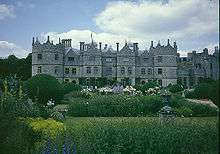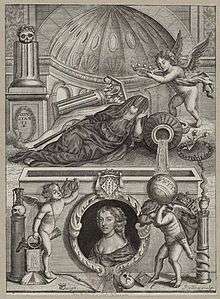Henry Hare, 2nd Baron Coleraine
| Henry Hare, 2nd Baron Coleraine | |
|---|---|
 Henry Hare, 2nd Baron Coleraine, engraving by William Faithorne and George Vertue | |
| Born |
21 April 1636 Totteridge, Hertfordshire |
| Died | 15 July 1708 (aged 72) |
| Nationality | British |
| Occupation | MP |
| Known for | Antiquary |
Henry Hare, 2nd Baron Coleraine (1636–1708) was an English politician and antiquary.
Life
Baptised at Totteridge, Hertfordshire, 21 April 1636, he was the eldest surviving son of Hugh Hare, 1st Baron Coleraine, by his wife Lucy, second daughter of the first marriage of Henry Montagu, 1st Earl of Manchester. He resided at Tottenham, Middlesex.[1]
Longford Castle in Wiltshire was a family property, and Coleraine was elected Member of Parliament for Old Sarum in 1679. He was unsuccessful as a candidate for Wiltshire in 1690.[2]

In 1696, Coleraine built a vestry at the east end of the north aisle of Tottenham parish church, and underneath a vault for his family. He was buried at Tottenham on 15 July 1708.[1]
Works
Coleraine corresponded with Dr. John Woodward on antiquarian subjects, and was tutored in numismatics by Walter Charleton.[1][3] He left in manuscript an account of Tottenham, which treats mainly the parochial charities. Richard Rawlinson purchased it from Thomas Osborne, the bookseller, and showed it to the Society of Antiquaries of London in 1755. It went to the Bodleian Library. Richard Gough had a transcript taken, for the appendix to Henry George Oldfield and Richard Randall Dyson's History and Antiquities of the Parish of Tottenham High-Cross (1790), where its authorship is attributed to Henry Hare, 3rd Baron Coleraine.[1]
Family
Coleraine was married three times:

- First to Constantia (died 1680), daughter of Sir Richard Lucy of Broxbourne, Hertfordshire, by whom he had Hugh Hare, and other children;
- Secondly to Sarah, Duchess-dowager of Somerset, widow of John Seymour, 4th Duke of Somerset (died 1692); and
- Thirdly, in 1696, to Elizabeth Portman (died 1732), widow of Robert Reade of Cheshunt, Hertfordshire.[1]
References
- 1 2 3 4 5 Goodwin 1890.
- ↑ historyofparliamentonline.org, Hare, Henry, 2nd Baron Coleraine (I) (1636-1708), of Longford Castle, Wilts. and Bruce Castle, Tottenham, Mdx.
- ↑ Joseph M. Levine, Dr. Woodward's Shield (1977), p. 325 note 45.
- Attribution
![]() This article incorporates text from a publication now in the public domain: Goodwin, Gordon (1890). "Hare, Henry (1636-1708)". In Stephen, Leslie; Lee, Sidney. Dictionary of National Biography. 24. London: Smith, Elder & Co. pp. 366–367.
This article incorporates text from a publication now in the public domain: Goodwin, Gordon (1890). "Hare, Henry (1636-1708)". In Stephen, Leslie; Lee, Sidney. Dictionary of National Biography. 24. London: Smith, Elder & Co. pp. 366–367.